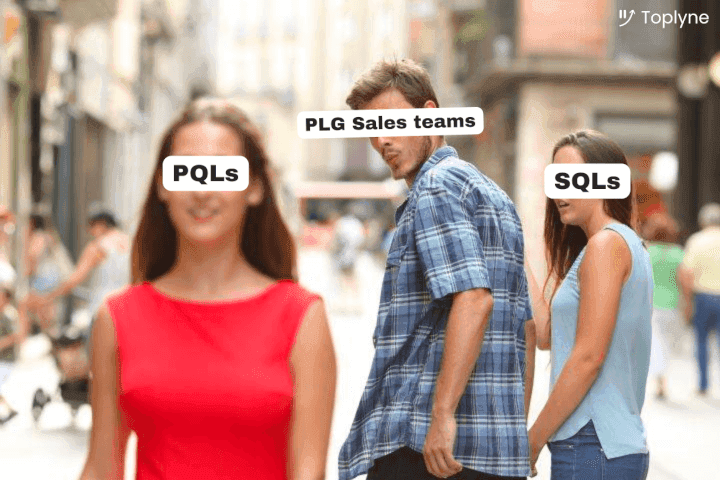PQL vs SQL: What’s the Difference (+Which to Focus On)
PQL vs SQL: What’s the Difference (+Which to Focus On)
PQL vs SQL: What’s the Difference (+Which to Focus On)
Discover the key differences between PQL vs SQL, which one to prioritize, and ways to optimize leads for your SaaS business.
Discover the key differences between PQL vs SQL, which one to prioritize, and ways to optimize leads for your SaaS business.
Discover the key differences between PQL vs SQL, which one to prioritize, and ways to optimize leads for your SaaS business.



In the past, companies have relied on sales qualified leads (SQLs) to identify users with a high probability of converting.
But has this been the most effective way of qualifying leads for a SaaS business?
Nuh-uh!
That’s why product qualified leads (PQLs) entered the SaaS competition, leaving everyone shocked! 👻

Wondering how the PQL strategy different from the standard sales and marketing qualified ones?
Don’t worry!
We’ll help you understand that and choose the PQL vs SQL winner. 🏆
This article will be your ultimate guide on PQL vs SQL and how they differ. We’ll also answer which one your SaaS company should focus on and give you handy tips to optimize your lead pipelines.
Lights, camera, action! 🎥
What Is PQL in Saas?
A product qualified lead (PQL) is a prospective customer who has experienced your product firsthand and derived meaningful value from it. This happens when users sign up for a free trial or freemium plan.
Essentially, it's a “try-before-you-buy” or “product led growth strategy that allows users to reach their “Aha! moment” early on in their customer journey.
In case you didn’t know:
The aha! moment is like the ✨hocus-pocus✨ moment or moment of sudden realization during product usage. It’s when a prospective customer can finally see the value of your product and says, “It’s a YES from me.”

That said, not all free users are product qualified.
What do we mean?
You can only press the golden buzzer 🟡 to declare them a product qualified lead once they’ve hit a certain product usage milestone.
Some examples of milestones other companies use for product qualification are:
Trial users reaching the 2,000 message limit in Slack.
A free user exhausting their 2GB storage limit in Dropbox.
A user adding 500 contacts in MailChimp.
In addition to hitting such milestones, a product qualified lead can have other characteristics like:
“Hand raisers” who have raised a query for sales assistance.
Prospective customers actively engaging with a specific product feature.
And even if the other leads have not asked for any assistance from your sales team yet, a PQL paves the way for product led sales. It makes the job of your sales team easier since the prospect understands your product’s value.
Now let’s move on to the next contestant — SQLs.
What Is SQL in SaaS?
Before we dive into SQLs, we’ll first need to understand its predecessors, IQL and MQL.
IQL or information qualified lead is a potential customer who has just begun researching a solution for their pain points. At this stage, these prospective customers are still unaware of your app’s value and how you can help them.
IQLs may have come across your website and provided their contact information in return for some helpful information, also known as a top-of-the-funnel offer. This could be an e-book, a whitepaper, or an infographic.
If the lead downloads any of these marketing resources…

You now have a marketing qualified lead (MQL)!
A marketing qualified lead is a prospect who has shown some interest in your product by interacting with marketing content.
So when does an SQL come into the scene?
A marketing qualified lead is not completely sold on the value of your SaaS product. Your marketing team needs to identify which prospect has buying intent and is willing to speak to your sales reps about it.
But how does your marketing team assess which leads are sales-qualified?
All they need is an effective lead scoring system.
A lead score attaches a value to each of your leads based on their actions. These actions could include viewing the product pricing page, inviting friends to try the product, etc.
Here are some examples of the positive actions for your lead scoring criteria:
Visiting your website a significant number of times
Downloading your SaaS product specifications sheet
Consistently opening your marketing emails
Taking part in your free webinars
Requesting a free quote
Their job title matches your ideal customer profile (ICP)
Likewise, certain negative actions could mean a no ❌:

A free user unsubscribing from your monthly newsletter
They don’t fit your ideal customer profile
After adding the positive scores for the actions and deducting the negative ones, if the lead achieves a desired lead qualification score, the marketing qualified lead becomes a sales qualified lead.
The marketing team then passes on these leads to the next round, where the sales team nurtures and potentially converts them.
Let’s now compare the SQL and PQL model based on specific parameters.
PQL vs SQL: 4 Key Differences
Here’s how a sales qualified lead differs from a product qualified lead:
1. Lead Generation Criteria
For a product qualified lead, in-app actions determine when the prospect is ready to become a paying customer.
On the other hand, a prospect will become a sales qualified lead if they match the ideal customer profile, have the budget to buy your product or service, have the infrastructure to use it, and have achieved the ideal lead score. Accordingly, they nurture an SQL to become paying customers.
Sales and customer success teams be like…

2. Customer Interaction
A product qualified lead may or may not want to talk to the sales team to make a purchase.
However, these potential customers may still need some nurturing. For example, if they’re getting stuck on a particular feature or are unable to checkout. In that case, your product engagement data could reveal the right time to engage with them.
Pro Tip: You can deploy a tool like Toplyne to automatically identify the right time to engage with different user segments and convert them faster.
This way, you only put them center stage when they’re ready to talk.
But a sales qualified lead usually speaks to a sales rep before purchasing. Based on the lead’s previous interaction with your brand, your reps can ask relevant questions or conduct product demos to help the user decide if your product is the right fit for them.
3. Main Sales Driver
For converting product qualified leads into paying customers, your product or service needs to be the ⭐star of the show⭐. In other words, your product team needs to create something that blows users away — toward checkout!
But, in the case of sales qualified leads, your sales team need to know the trick of the trade to convince a user to purchase. Your sales reps drive your brand’s success. 🤵
4. Customer Acquisition Costs
Customer acquisition cost, or CAC, is the amount spent on acquiring every new customer. This SaaS metric is generally lower for PQLs than SQLs.
Why?
When your product does all the convincing for you, it leads to shorter sales cycles. And when a conversion requires less time and effort from sales reps, it leads to lower acquisition costs.
However, in the case of sales qualified leads, you'll need to invest in an experienced customer success and sales team to nurture a potential customer and close the deal.
Which means…

Yup — higher expenses!
So, are PQLs and SQLs a trade-off?
We’ll answer that next.
PQLs or SQLs: Who Has the X Factor?
By their very nature, product qualified leads have already used your product or service. They understand how it works and have derived value from it. Since your product has already helped them address their pain points, they have a high buying intent, and the sales process is more of a formality.

Moreover, a PQL strategy allows you to use actual product data to accurately identify which leads are ready for the conversion talk instead of relying on arbitrary factors (like website visits or email opens).
But that’s not all.
Your sales rep can also use this product usage data to see their app usage patterns and shape their sales calls accordingly (in case your leads need a little nudge to convert). This ultimately increases the likelihood of free-to-paid conversions.
In fact, according to Tomasz Tunguz, ex MD, Redpoint (a VC firm), PQLs have a 6x times higher conversion rate than SQLs.
Bottom line?
The PQL model can work exceptionally well for SaaS companies because you can easily allow users to try out your app before making serious commitments and gauge their interest. Plus, there's negligible cost to serve involved. A win-win!
So if you believe that your App’s Got Talent, there are a few ways to better leverage your product qualified leads.
Three Ways to Optimize PQLs for Your SaaS Company
Here are three ways you can make better use of your product qualified leads:
1. Prioritize PQLs According to Your ICP
Even if a prospect takes all the right in-app actions, they may still not be your ideal customer. For example, they may be an app reviewer trying out your product or a student who only wants to use the basic features for a once-off project.
So, it becomes imperative to prioritize the leads that match your ideal customer profile. For example, you may offer your service in a specific geographical area, so spending time and effort on leads outside that boundary won’t make sense.
Likewise, you may have an enterprise-level app. In that case, you could de-prioritize smaller businesses that try it out.
Bottomline: Segment your leads based on your key metrics.
2. Have a Fantastic Customer Onboarding System
First impressions matter — whether it’s a talent show, a job interview, or a casual date.

The same holds true for product qualified leads.
That’s why customer onboarding is one of the most powerful tools to create a lasting impression on your leads and lead them to success.
From signing up for the free trial to becoming a paid customer, your sales team should be there to help your leads get through each stage of the sales funnel.
But not just that.
User onboarding can be an excellent way to introduce, promote, and highlight product features and use cases. This can help users derive even more value from your product and achieve customer success.
Discover how to create a kickass onboarding experience.
3. Use Toplyne to Build a Pipeline of Product Qualified Leads
Sales teams in product led growth companies know they could have a smarter sales process.
So what’s stopping them?
It’s the arduous task of processing and making sense of all that user data. And by the time they derive some meaning, the ship has already sailed. *oops*

Instead of thinking about how to salvage the situation later, what they need is an intelligent tool to process product usage data and identify when it’s the right time to step in.
Enter Toplyne.
Toplyne is a one-of-a-kind headless Sales AI that works in the background to surface a pipeline of product-qualified leads. It does so by using product usage insights from different data sources like Amplitude, Mixpanel, etc., and operationalizing them within your existing sales tools. This way, it can help achieve key metrics like high conversion rates that PQLs typically deliver.
By identifying the right leads, this tool also helps you increase your win rate and improves your NRR (net revenue retention) via upselling and cross-sell opportunities.
Here’s how companies like Canva and Vercel generate sales pipeline from their self-serve funnel using Toplyne:
Step 1/7: Create monetization playbooks to surface conversion and expansion opportunities (leads most likely to convert to paying customers, and teams most likely to grow into larger teams)

Step 2/7: Choose the right leads to target – users (individual users) or accounts (a group of users with an organization).

Step 3/7: Select the frequency at which you would want leads synced in your GTM apps.

Step 4/7: Define how many leads you want by either the number of leads or your expected win rate, depending on your sales capacity and GTM strategy.

Step 5/7: Build custom segments - Build custom segments based on And/Or logic at the deepest level of sub-properties within your product analytics.

Step 6/7: Validate your GTM strategy - Hold back some users as a control group to test your GTM strategy.

Step 7/7: Sync your product qualified pipeline into your GTM destinations - CRMs, sales & marketing execution tools, and customer engagement platforms.

Let your PQLs Take Center Stage with Toplyne
PQLs and SQLs are two prominent ways of categorizing leads, and both are equally important.
Yet, PQLs often steal the show since they help fast-track product adoption by letting users experience it firsthand.
And with an intuitive tool like Toplyne as your prop, you can expect to give a stellar PQL-generating performance every time.
This behavioral AI tool can intuitively spot the right conversion and expansion opportunities without changing your sales stack.
But that’s not all.
Toplyne can go beyond product qualification by helping you reach out to different user segments and convert them effortlessly.
Why wait?
Sign up for free today to discover your product’s biggest fans — PQLs.

In the past, companies have relied on sales qualified leads (SQLs) to identify users with a high probability of converting.
But has this been the most effective way of qualifying leads for a SaaS business?
Nuh-uh!
That’s why product qualified leads (PQLs) entered the SaaS competition, leaving everyone shocked! 👻

Wondering how the PQL strategy different from the standard sales and marketing qualified ones?
Don’t worry!
We’ll help you understand that and choose the PQL vs SQL winner. 🏆
This article will be your ultimate guide on PQL vs SQL and how they differ. We’ll also answer which one your SaaS company should focus on and give you handy tips to optimize your lead pipelines.
Lights, camera, action! 🎥
What Is PQL in Saas?
A product qualified lead (PQL) is a prospective customer who has experienced your product firsthand and derived meaningful value from it. This happens when users sign up for a free trial or freemium plan.
Essentially, it's a “try-before-you-buy” or “product led growth strategy that allows users to reach their “Aha! moment” early on in their customer journey.
In case you didn’t know:
The aha! moment is like the ✨hocus-pocus✨ moment or moment of sudden realization during product usage. It’s when a prospective customer can finally see the value of your product and says, “It’s a YES from me.”

That said, not all free users are product qualified.
What do we mean?
You can only press the golden buzzer 🟡 to declare them a product qualified lead once they’ve hit a certain product usage milestone.
Some examples of milestones other companies use for product qualification are:
Trial users reaching the 2,000 message limit in Slack.
A free user exhausting their 2GB storage limit in Dropbox.
A user adding 500 contacts in MailChimp.
In addition to hitting such milestones, a product qualified lead can have other characteristics like:
“Hand raisers” who have raised a query for sales assistance.
Prospective customers actively engaging with a specific product feature.
And even if the other leads have not asked for any assistance from your sales team yet, a PQL paves the way for product led sales. It makes the job of your sales team easier since the prospect understands your product’s value.
Now let’s move on to the next contestant — SQLs.
What Is SQL in SaaS?
Before we dive into SQLs, we’ll first need to understand its predecessors, IQL and MQL.
IQL or information qualified lead is a potential customer who has just begun researching a solution for their pain points. At this stage, these prospective customers are still unaware of your app’s value and how you can help them.
IQLs may have come across your website and provided their contact information in return for some helpful information, also known as a top-of-the-funnel offer. This could be an e-book, a whitepaper, or an infographic.
If the lead downloads any of these marketing resources…

You now have a marketing qualified lead (MQL)!
A marketing qualified lead is a prospect who has shown some interest in your product by interacting with marketing content.
So when does an SQL come into the scene?
A marketing qualified lead is not completely sold on the value of your SaaS product. Your marketing team needs to identify which prospect has buying intent and is willing to speak to your sales reps about it.
But how does your marketing team assess which leads are sales-qualified?
All they need is an effective lead scoring system.
A lead score attaches a value to each of your leads based on their actions. These actions could include viewing the product pricing page, inviting friends to try the product, etc.
Here are some examples of the positive actions for your lead scoring criteria:
Visiting your website a significant number of times
Downloading your SaaS product specifications sheet
Consistently opening your marketing emails
Taking part in your free webinars
Requesting a free quote
Their job title matches your ideal customer profile (ICP)
Likewise, certain negative actions could mean a no ❌:

A free user unsubscribing from your monthly newsletter
They don’t fit your ideal customer profile
After adding the positive scores for the actions and deducting the negative ones, if the lead achieves a desired lead qualification score, the marketing qualified lead becomes a sales qualified lead.
The marketing team then passes on these leads to the next round, where the sales team nurtures and potentially converts them.
Let’s now compare the SQL and PQL model based on specific parameters.
PQL vs SQL: 4 Key Differences
Here’s how a sales qualified lead differs from a product qualified lead:
1. Lead Generation Criteria
For a product qualified lead, in-app actions determine when the prospect is ready to become a paying customer.
On the other hand, a prospect will become a sales qualified lead if they match the ideal customer profile, have the budget to buy your product or service, have the infrastructure to use it, and have achieved the ideal lead score. Accordingly, they nurture an SQL to become paying customers.
Sales and customer success teams be like…

2. Customer Interaction
A product qualified lead may or may not want to talk to the sales team to make a purchase.
However, these potential customers may still need some nurturing. For example, if they’re getting stuck on a particular feature or are unable to checkout. In that case, your product engagement data could reveal the right time to engage with them.
Pro Tip: You can deploy a tool like Toplyne to automatically identify the right time to engage with different user segments and convert them faster.
This way, you only put them center stage when they’re ready to talk.
But a sales qualified lead usually speaks to a sales rep before purchasing. Based on the lead’s previous interaction with your brand, your reps can ask relevant questions or conduct product demos to help the user decide if your product is the right fit for them.
3. Main Sales Driver
For converting product qualified leads into paying customers, your product or service needs to be the ⭐star of the show⭐. In other words, your product team needs to create something that blows users away — toward checkout!
But, in the case of sales qualified leads, your sales team need to know the trick of the trade to convince a user to purchase. Your sales reps drive your brand’s success. 🤵
4. Customer Acquisition Costs
Customer acquisition cost, or CAC, is the amount spent on acquiring every new customer. This SaaS metric is generally lower for PQLs than SQLs.
Why?
When your product does all the convincing for you, it leads to shorter sales cycles. And when a conversion requires less time and effort from sales reps, it leads to lower acquisition costs.
However, in the case of sales qualified leads, you'll need to invest in an experienced customer success and sales team to nurture a potential customer and close the deal.
Which means…

Yup — higher expenses!
So, are PQLs and SQLs a trade-off?
We’ll answer that next.
PQLs or SQLs: Who Has the X Factor?
By their very nature, product qualified leads have already used your product or service. They understand how it works and have derived value from it. Since your product has already helped them address their pain points, they have a high buying intent, and the sales process is more of a formality.

Moreover, a PQL strategy allows you to use actual product data to accurately identify which leads are ready for the conversion talk instead of relying on arbitrary factors (like website visits or email opens).
But that’s not all.
Your sales rep can also use this product usage data to see their app usage patterns and shape their sales calls accordingly (in case your leads need a little nudge to convert). This ultimately increases the likelihood of free-to-paid conversions.
In fact, according to Tomasz Tunguz, ex MD, Redpoint (a VC firm), PQLs have a 6x times higher conversion rate than SQLs.
Bottom line?
The PQL model can work exceptionally well for SaaS companies because you can easily allow users to try out your app before making serious commitments and gauge their interest. Plus, there's negligible cost to serve involved. A win-win!
So if you believe that your App’s Got Talent, there are a few ways to better leverage your product qualified leads.
Three Ways to Optimize PQLs for Your SaaS Company
Here are three ways you can make better use of your product qualified leads:
1. Prioritize PQLs According to Your ICP
Even if a prospect takes all the right in-app actions, they may still not be your ideal customer. For example, they may be an app reviewer trying out your product or a student who only wants to use the basic features for a once-off project.
So, it becomes imperative to prioritize the leads that match your ideal customer profile. For example, you may offer your service in a specific geographical area, so spending time and effort on leads outside that boundary won’t make sense.
Likewise, you may have an enterprise-level app. In that case, you could de-prioritize smaller businesses that try it out.
Bottomline: Segment your leads based on your key metrics.
2. Have a Fantastic Customer Onboarding System
First impressions matter — whether it’s a talent show, a job interview, or a casual date.

The same holds true for product qualified leads.
That’s why customer onboarding is one of the most powerful tools to create a lasting impression on your leads and lead them to success.
From signing up for the free trial to becoming a paid customer, your sales team should be there to help your leads get through each stage of the sales funnel.
But not just that.
User onboarding can be an excellent way to introduce, promote, and highlight product features and use cases. This can help users derive even more value from your product and achieve customer success.
Discover how to create a kickass onboarding experience.
3. Use Toplyne to Build a Pipeline of Product Qualified Leads
Sales teams in product led growth companies know they could have a smarter sales process.
So what’s stopping them?
It’s the arduous task of processing and making sense of all that user data. And by the time they derive some meaning, the ship has already sailed. *oops*

Instead of thinking about how to salvage the situation later, what they need is an intelligent tool to process product usage data and identify when it’s the right time to step in.
Enter Toplyne.
Toplyne is a one-of-a-kind headless Sales AI that works in the background to surface a pipeline of product-qualified leads. It does so by using product usage insights from different data sources like Amplitude, Mixpanel, etc., and operationalizing them within your existing sales tools. This way, it can help achieve key metrics like high conversion rates that PQLs typically deliver.
By identifying the right leads, this tool also helps you increase your win rate and improves your NRR (net revenue retention) via upselling and cross-sell opportunities.
Here’s how companies like Canva and Vercel generate sales pipeline from their self-serve funnel using Toplyne:
Step 1/7: Create monetization playbooks to surface conversion and expansion opportunities (leads most likely to convert to paying customers, and teams most likely to grow into larger teams)

Step 2/7: Choose the right leads to target – users (individual users) or accounts (a group of users with an organization).

Step 3/7: Select the frequency at which you would want leads synced in your GTM apps.

Step 4/7: Define how many leads you want by either the number of leads or your expected win rate, depending on your sales capacity and GTM strategy.

Step 5/7: Build custom segments - Build custom segments based on And/Or logic at the deepest level of sub-properties within your product analytics.

Step 6/7: Validate your GTM strategy - Hold back some users as a control group to test your GTM strategy.

Step 7/7: Sync your product qualified pipeline into your GTM destinations - CRMs, sales & marketing execution tools, and customer engagement platforms.

Let your PQLs Take Center Stage with Toplyne
PQLs and SQLs are two prominent ways of categorizing leads, and both are equally important.
Yet, PQLs often steal the show since they help fast-track product adoption by letting users experience it firsthand.
And with an intuitive tool like Toplyne as your prop, you can expect to give a stellar PQL-generating performance every time.
This behavioral AI tool can intuitively spot the right conversion and expansion opportunities without changing your sales stack.
But that’s not all.
Toplyne can go beyond product qualification by helping you reach out to different user segments and convert them effortlessly.
Why wait?
Sign up for free today to discover your product’s biggest fans — PQLs.

Related Articles




Behavioral Retargeting: A Game-Changer in the Cookieless Era
Unlock the power of behavioral retargeting for the cookieless future! Learn how it personalizes ads & boosts conversions. #behavioralretargeting




All of Toplyne's 40+ Badges in the G2 Spring Reports
Our customers awarded us 40+ badges in G2's Summer Report 2024.




Unlocking the Full Potential of Google PMax Campaigns: Mastering Audience Selection to Double Your ROAS
Copyright © Toplyne Labs PTE Ltd. 2024
Copyright © Toplyne Labs PTE Ltd. 2024
Copyright © Toplyne Labs PTE Ltd. 2024
Copyright © Toplyne Labs PTE Ltd. 2024